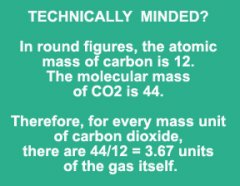Anthropogenic global climate change
Since 1750, it is estimated that about two thirds of anthropogenic climate change CO2 emissions have come from fossil fuel burning (coal and petroleum) and about one third from land use change (mainly deforestation and agricultural). About 45% of this CO2 has remained in the atmosphere, while about 30% has been taken up by the oceans and the remainder has been taken up by the trees and plants. About half of a CO2 going into the atmosphere is removed over a time scale of 30 years; a further 30% is removed within a few centuries; and the remaining 20% will typically stay in the atmosphere for many thousands of years.
In recent decades, carbon emissions have continued to increase. Global annual fossil emissions increased from an average of 6.4 GtC yr (one giga tonne of carbon per year) in the 1990s to 7.2 GtC yr in the period 2000 to 2005. Fossil fuel use is not the only human contribution to carbon dioxide levels, and at least another 1.6GtC should be added for emissions from land use. To gain some idea of figures we are talking about here, 1 GtC is equal to 1, 000, 000, 000 metric tonnes, that is one billion tonnes.

While you think about these numbers, it should be pointed out that when using the emission factors above, 1 GtC (carbon) corresponds to 3.67 GtCO2 (carbon dioxide). The box above shows why 1GtC = 3.67GCO2, and we will now work out how Many Gt of CO2 are emitted every year (and still rising). Firstly, we can add fossil fuel emissions 7.2 to land use, 1.6 to come up with a total of 8.8GtC annually. Secondly, we multiply 8.8 x 3.67 and so we have a total of 32.29GtCO2 being emitted to the atmosphere each year!
In addition to escalating coal use after the Industrial Revolution, came the widespread use of another fossil fuel; petroleum for transport. At the beginning of the 20th century, annual global oil output was about 150 million barrels of oil, now, that amount is extracted globally in just two days.
Look at the graph at the top of the page again, and see how concentrations of CO2, CH4 and N20 have risen almost vertically in recent years. The vertical pathway is cause for alarm, as CO2 levels correlate highly with an increase in average global surface temperatures.


 Climate change denial is a set of organized attempts to downplay, deny or dismiss the scientific consensus on the extent of global warming, its significance, and its connection to human behavior, especially for commercial or ideological reasons. Typically, these attempts take the rhetorical form of legitimate scientific debate, while not...
Climate change denial is a set of organized attempts to downplay, deny or dismiss the scientific consensus on the extent of global warming, its significance, and its connection to human behavior, especially for commercial or ideological reasons. Typically, these attempts take the rhetorical form of legitimate scientific debate, while not...